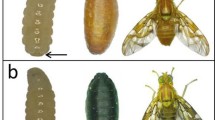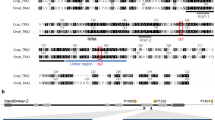Summary
Using the alcohol dehydrogenase (ADH) locus a genetic sexing system is being developed in the Mediterranean fruit fly Ceratitis capitata based on the sensitivity of ADH null mutations to environmental ethanol. A series of null mutants have been induced at this locus, however, none proved viable as homozygotes. One of these null mutants was translocated to the male determining chromosome and this line can be used for genetic sexing. When larvae from this line were reared on larval medium containing various concentrations of allyl alcohol, 97% of the emerging adults were males; in the absence of the allyl alcohol the sex ratio in the line is distorted in favour of the females. It is proposed that the higher ADH activity of the females (homozygous positive) in comparison with the males (heterozygous null) is responsible for their lower survival in larval medium containing allyl alcohol. ADH converts the allyl alcohol to the lethal ketone. The possible use of this line to sex large populations of medflies for use in sterile insect release programmes is discussed.
Similar content being viewed by others
References
Freeling M, Cheng DSK (1978) Radiation induced alcohol dehydrogenase mutants in maize following allyl alcohol selection of pollen. Genet Res 31:107–129
O'Donnel J, Gerace L, Leister F, Sofer W (1975) Chemical selection of mutants that affect alcohol dehydrogenase in Drosophila. 2. Use of l-pentyne-3-ol. Genetics 79:73–83
Oakeshott JG (1976) Selection at the alcohol dehydrogenase locus in Drosophila melanogaster imposed by environmental ethanol. Genet Res 26:265–274
Riva ME, Robinson AS (1983) Studies on the ADH locus in Ceratitis capitata. In: 10 BC/CEC Workshop “Fruit flies of economic importance”. Balkema, Rotterdam, pp 163–171
Riva ME, Robinson AS (1986) Induction of alcohol dehydrogenase (Adh) null mutants in the Medfly, Ceratitis capitata. Biochem Genet (in press)
Robinson AS (1983) Sex ratio manipulation in relation to insect pest control. Annu Rev Genet 17:191–214
Robinson AS, Heemert C van (1982) Ceratitis capitata, a suitable case for genetic sexing. Genetica 58:229–237
Robinson AS, Riva ME (1984) A simple method for the isolation of allelic series using male-linked translocations. Theor Appl Genet 67:305–306
Sofer WH, Hatkoff MA (1972) Chemical selection of alcohol dehydrogenase negative mutants in Drosophila. Genetics 72:545–549
Author information
Authors and Affiliations
Additional information
Communicated by H.F. Linskens
Rights and permissions
About this article
Cite this article
Robinson, A.S., Riva, M.E. & Zapater, M. Genetic sexing in the mediterranean fruit fly, Ceratitis capitata, using the alcohol dehydrogenase locus. Theoret. Appl. Genetics 72, 455–457 (1986). https://doi.org/10.1007/BF00289526
Received:
Accepted:
Issue Date:
DOI: https://doi.org/10.1007/BF00289526




